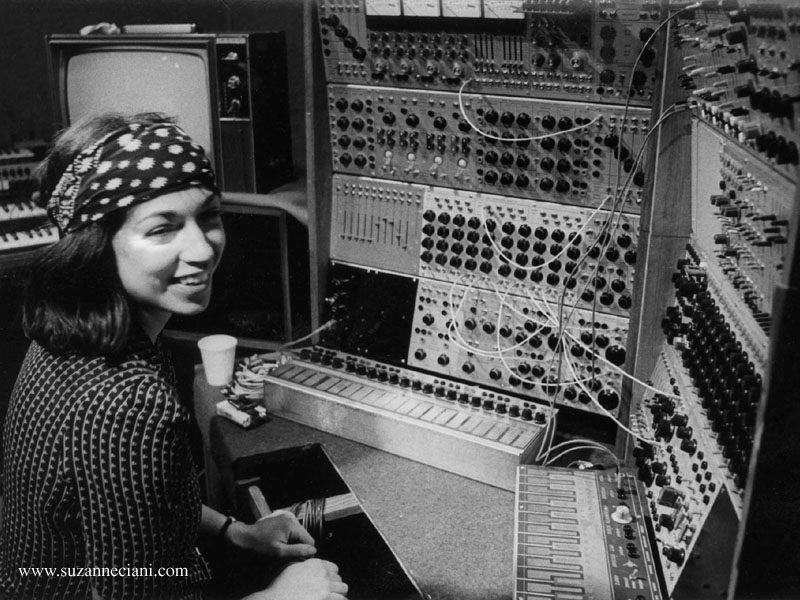No products in the cart.
🇺🇸 EN
Daphne Oram and Delia Derbyshire: The Overlooked Pioneers of Electronic Music
Forgotten names in sound history
While names like Kraftwerk, Jean-Michel Jarre, or Brian Eno are often cited when tracing the history of electronic music, few people know of Daphne Oram and Delia Derbyshire. These two British composers played a crucial role in the emergence of experimental electronic music, at a time when recording studios were overwhelmingly male-dominated.
Daphne Oram: The visionary inventor
Born in 1925, Daphne Oram was one of the first composers to explore electronic sound manipulation. In 1957, she co-founded the BBC Radiophonic Workshop, a department dedicated to creating experimental music and sound effects for radio and television.
In 1959, she invented the Oramics Machine, a revolutionary device that allowed music composition by drawing on transparent film strips. This system translated drawings into instructions for sound manipulation. With this invention, Oram became a true architect of sound, laying the groundwork for modern sound design and influencing generations of electronic musicians.


Despite her technical and artistic innovations, Oram’s contributions were often overlooked. She left the BBC Radiophonic Workshop in 1960 to continue independent research, experimenting until her death in 2003.
Delia Derbyshire: The sound alchemist behind Doctor Who
Born in 1937, Delia Derbyshire joined the BBC Radiophonic Workshop in 1960. She developed a unique style, combining tape manipulation and oscillators. Her most famous work remains the arrangement of the Doctor Who theme in 1963, originally composed by Ron Grainer. This piece, one of the first electronic TV themes, left a lasting impression with its futuristic, avant-garde quality.
Derbyshire’s work went beyond Doctor Who. She collaborated with various artists and explored electronic music’s potential at a time when few women had access to these technologies. Yet, she wasn’t fully credited for her contributions. She left the BBC in 1973 and stepped away from music before receiving late recognition just before her death in 2001.
Why are these figures overlooked?
The lack of recognition for Daphne Oram and Delia Derbyshire stems from several factors: prevalent sexism in technical and musical fields, the perception that their work was merely “technical” rather than creative, and a general tendency to erase women from historical narratives.
Today, their works are being rediscovered and celebrated. Exhibitions, documentaries like “The Delian Mode” (2009), and academic research are helping to restore their rightful place in electronic music history.
Restoring their legacy
Acknowledging Daphne Oram and Delia Derbyshire means recognizing that electronic music history was not written solely by men. Their innovations paved the way for sound creators who continue to explore new sonic frontiers today.
WATCH :
🇫🇷 FR
Des noms souvent oubliés de l’histoire du son
Si les noms de Kraftwerk, Jean-Michel Jarre ou encore Brian Eno sont familiers lorsqu’il s’agit de retracer l’histoire de la musique électronique, peu de gens connaissent ceux de Daphne Oram et Delia Derbyshire. Pourtant, ces deux compositrices britanniques ont joué un rôle crucial dans l’émergence de la musique électronique expérimentale, à une époque où les studios d’enregistrement étaient encore largement dominés par les hommes.
Daphne Oram : L’inventrice visionnaire
Née en 1925, Daphne Oram est l’une des premières compositrices à s’intéresser aux manipulations sonores électroniques. En 1957, elle cofonde le BBC Radiophonic Workshop, un département de la BBC destiné à produire des effets sonores et des musiques expérimentales pour la radio et la télévision.
En 1959, elle invente l’Oramics Machine, une machine révolutionnaire qui permettait de composer de la musique en dessinant directement sur une bande de film transparent. Ce processus traduisait les dessins en commandes pour manipuler le son. Avec cette invention, Oram devint une véritable architecte du son, posant les bases du sound design moderne et influençant des générations de musiciens électroniques.
Malgré ses innovations techniques et artistiques, ses contributions ont souvent été sous-estimées ou reléguées au second plan. Elle quitta le BBC Radiophonic Workshop en 1960 pour poursuivre ses recherches indépendantes, continuant à expérimenter jusqu’à sa mort en 2003.
Delia Derbyshire : L’alchimiste sonore derrière Doctor Who
Née en 1937, Delia Derbyshire rejoint le BBC Radiophonic Workshop en 1960. Elle y développe un style unique, combinant manipulations de bandes magnétiques et utilisation d’oscillateurs. Son œuvre la plus emblématique reste l’arrangement du thème de Doctor Who en 1963, une composition originale de Ron Grainer. Ce morceau, considéré comme l’un des premiers thèmes électroniques pour la télévision, a marqué les esprits par son caractère futuriste et avant-gardiste.
Le travail de Derbyshire ne se limite pas à Doctor Who. Elle a collaboré avec divers artistes et exploré les possibilités offertes par la musique électronique dans un contexte où peu de femmes avaient accès à ces technologies. Pourtant, à l’époque, elle ne reçut pas le crédit qu’elle méritait pleinement. Elle quitta la BBC en 1973 et s’éloigna quelque peu de la musique avant de connaître une reconnaissance tardive, juste avant sa mort en 2001.
Pourquoi ces figures restent-elles dans l’ombre ?
Le manque de reconnaissance pour Daphne Oram et Delia Derbyshire s’explique par une combinaison de facteurs : le sexisme omniprésent dans le milieu technique et musical de l’époque, le fait que leurs contributions étaient souvent perçues comme du simple travail de “techniciennes” plutôt que de véritables créations artistiques, et une tendance générale à invisibiliser les femmes dans les récits historiques.
Aujourd’hui, leurs œuvres sont redécouvertes et célébrées. Des expositions, des films documentaires comme « The Delian Mode » (2009) et des recherches académiques contribuent à restaurer leur place dans l’histoire de la musique électronique.
Redonner à ces pionnières leur juste place
Reconnaître Daphne Oram et Delia Derbyshire, c’est reconnaître que l’histoire de la musique électronique ne s’est pas écrite uniquement au masculin. Leurs innovations ont ouvert des voies qui continuent d’influencer les créateurs sonores contemporains.
REGARDER :



